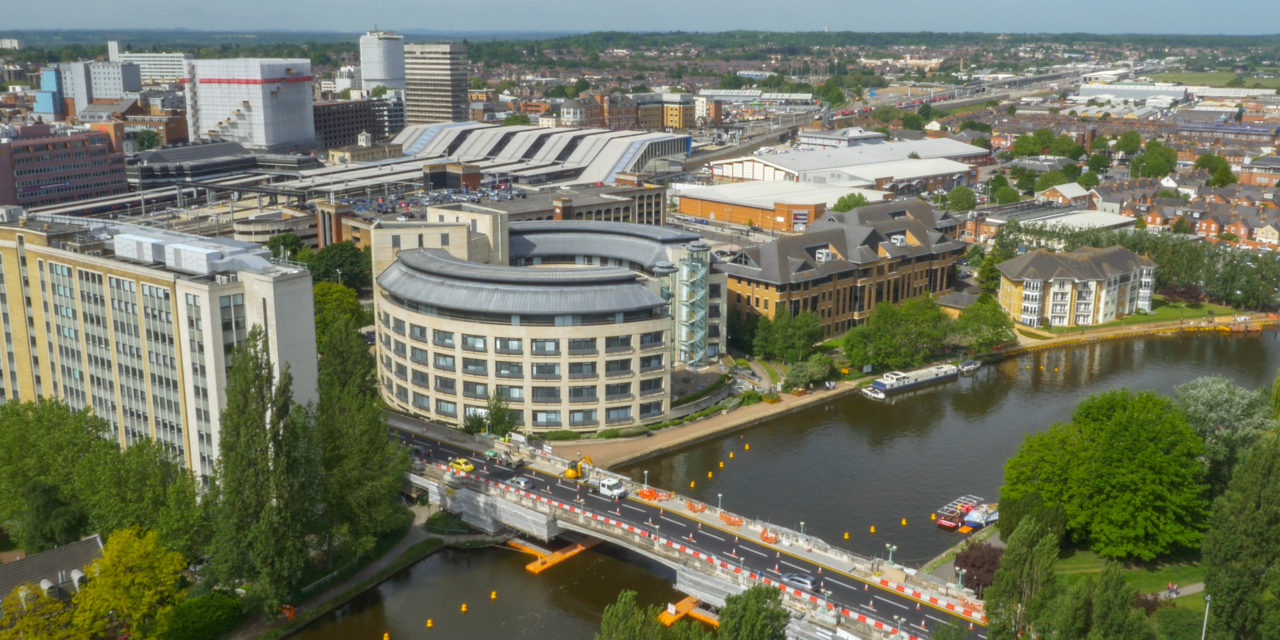In a prime position at the heart of the Thames Valley and with a flourishing information and communications sector, Reading looks well set to meet the challenges posed by the pandemic. Philip Brown, head of office at Savills Reading, looks at where opportunities could lie for future growth, along with expert insight from his colleagues and the wider Savills team.
Whether it was juggling working from home with the demands of home schooling, or getting to grips with the mute button on Zoom or Microsoft Teams, the unparalleled events of the last 12 months have forced us all to adapt to a new way of doing business. Fortunately, Reading and the wider Thames Valley appear well-positioned to meet the challenge.
A recent report by financial and legal advisors Irwin Mitchell forecast that Reading was set for 4.9 per cent annual GVA growth by the end of this year and annual employment growth of 6.6 per cent and 10 per cent in quarters two and four of 2021 respectively. Outer London by contrast is expected to be propping up the employment table on -8.9 per cent.
There is certainly every reason to be positive. Spearheaded by global heavyweights Microsoft and Oracle, the town’s information and communications sector continues to thrive, while the reputation of the university goes from strength to strength and Reading and the Thames Valley is forging an excellent name for itself in the world of film and media.
Future investment is planned at Green Park by telecommunications firm Three UK and the nearby Reading International Business Park will shortly undergo a transformation, while central Reading is amongst the best-connected locations in the south east thanks to the significant investment in the town’s station and the imminent arrival of Crossrail.
Residential and new homes
Reading’s popularity means that it is fast becoming a key focus for developers and investors who see its potential for growth.
Large scale mixed-use projects where residential, retail and office space combine are transforming the town centre and creating new, vibrant destinations for living and working. Schemes such as Berkeley’s Huntley Wharf, CNM Estates’ Verto and Station Hill by Lincoln MGT are extremely exciting prospects that would sit comfortably in central London or other large cities.
Alexa Peters, who leads our residential development sales team, believes regional centres such as Reading will become even more popular as lockdown restrictions are eased and buyers continue to re-evaluate their home/work balance. As borders start to re-open she is also expecting to see an increase in international buyers looking for both investment opportunities and permanent homes outside of London.
The imminent arrival of Crossrail and the town’s inclusion on the tube map will likely increase that potential further, while the Government’s Help to Buy scheme continues to attract a young, dynamic and upwardly mobile demographic.
Gordon Hood oversees our lettings business in Reading. He comments that while he saw tenants’ search requirements shift last year, with an uplift in demand for more remote locations, outside space and work from home set-ups, in recent months this has started to change again as tenants prepare for a return to the office and are therefore focusing on locations with good connectivity to London and other major towns and cities, including Reading.
Despite the current gap between rental supply and demand, he expects the market to progressively stabilise, with stronger rental growth in 2022 and beyond.
This, with capital appreciation too, means landlords should maintain their assets and continue to look at the rental market for investment. Nine out of ten of recent lettings transactions locally have been at the asking price or above, with competitive bidding being a common occurrence in the family house market too.
Development land
While there will no doubt be new challenges ahead with the ongoing stages of Brexit, easing of Covid-19 restrictions, climate change and the wider economy, housing delivery remains very much at the forefront of the Government agenda.
Historically demand has outstripped supply in the Thames Valley land market and that shows very little sign of change.
Ed Keeling, who heads up our development team, reports that housebuilders have adjusted their hurdle rates (the minimum acceptable rate of return on investment) and margins downwards this year so they can be as competitive as possible on land acquisitions, while seeking to maintain build quality by holding their construction costs.
The key issue is an ongoing, general shortage of suitable sites, particularly in relation to family housing and standalone schemes. High sales rates in 2020 have depleted housebuilders’ stocks, meaning land replenishment is likely to be a central feature of 2021.
All these ingredients suggest the land market across the region will continue to be both active and competitive throughout the next 12 months and beyond.
Office space
There’s no doubt that last year was a challenge. But the recurring theme from our conversations with occupiers is that the office is far from dead. In fact, the latest lockdown has only confirmed that working from home certainly does not suit everyone.
Flexibility will be an important consideration as businesses navigate their way through a post-Covid world and we expect larger occupiers and corporates to look closely at their strategies and wider portfolios.
Olivia Jones, from our national offices team, expects to see a new ‘hybrid’ approach to office occupation – most recently demonstrated by Three’s move from Reading town centre to Green Park.
The recent planning approval for Station Hill also brings a significant vote of confidence, while in the town centre alone there is currently more than 39,000 sq ft of space under offer or exchanged across nine deals. This already represents 71 per cent of 2020’s town centre take up and indicates signs of pent-up demand.
Technology sector
Reading sits high up within rankings of UK and European locations for depth and intensity of technology and innovation. In fact, Tech Nation has reported the town as having eight times the UK average concentration of digital tech companies.
Using data collected in-house by Savills, Steve Lang, who analyses the south east office markets, highlights that over the past five years the technology sector has accounted for 42 per cent of the total take-up of commercial office space, amounting to just under one million sq. ft. – making it the most prominent sector. Over the past twenty years it has accounted for over 4.1 million sq ft of commercial space in the area.
The presence of technology firms, from the very largest, including global and European headquarters, to the thriving start-up community, supports a rich and dynamic business community and cements it as a location that will continue to attract more occupiers in the future.
An analysis of venture capital raised by companies headquartered in and around Reading also highlights a technology bias. Of the £700 million raised over the past decade, a third has been from within the ‘software’ sub-sector and a fifth from ‘networking and communications’. This is substantial and points to Reading’s future growth as a technology location, with headcount growth and a corresponding increase in demand for commercial floor space expected.
Lockdown demonstrated that while many employees can work productively from home, face-to-face collaboration, networking and mentoring are not easily achievable. These are critical tools within technology companies and therefore we expect to see occupiers re-focusing on location – including in-town and out-of-town provision – and quality of floor space.
Industrial and logistics
The industrial and logistics sectors in the Thames Valley have witnessed strong demand over recent years, driven by the rise of online retail which saw an acceleration through 2020 due to Covid-19. This growth has gone hand in hand with an increase in the scale of facilities and the levels of power that occupiers require as they invest heavily in technology to improve the efficiencies of their operations.
Toby Green, who heads up our industrial team in London and is responsible for the south east, says the M4 corridor has been a growth area for film and data centres, which commonly acquire land or warehouses with B2/B8 planning in place.
However, he reports Reading and its surrounds continue to be constrained by supply of suitable land – with no sites with planning consented able to accommodate large scale distribution warehousing. This limited choice for expansion and relocation will likely exacerbate upward pressure on rents, leaving occupiers to consider other locations if land isn’t available.
It is apparent that the property markets in Reading and the Thames Valley have remained resilient in the face of the challenges brought by the pandemic. This bodes well for post-Covid recovery, with more cause for optimism coming from the successful vaccine roll-out and the positive progress along England’s roadmap for easing the restrictions.
If you would like advice or guidance in relation to any aspect of the local property market please contact our team on +44 (0)118 952 0500.
© Thames Tap (powered by ukpropertyforums.com).
Sign up to receive your free weekly Thames Tap newsletter here.
















